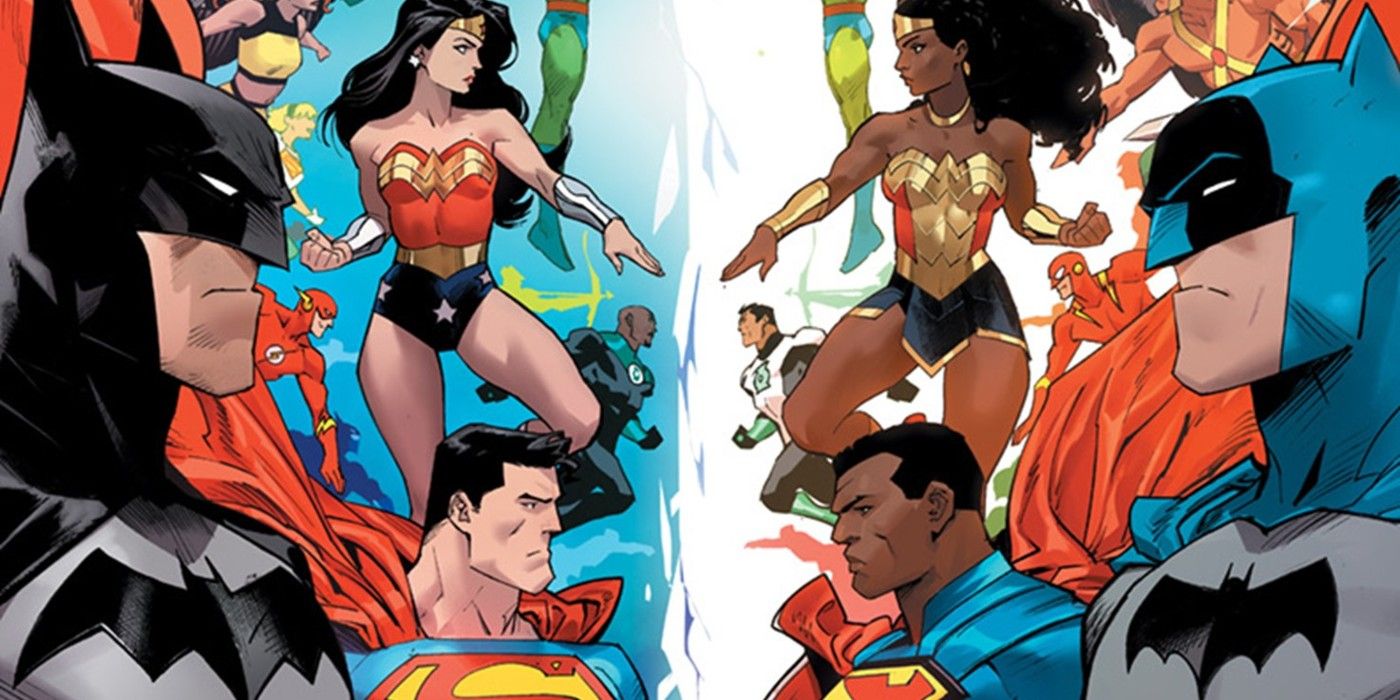[[{“value”:”
Summary
The Flash
#123 introduced the concept of the Multiverse, paving the way for numerous crossovers between Earths.
Significant DC events like
Crisis on Infinite Earths
and Morrison’s
The Multiversity
shaped the Multiverse and DC’s continuity.
Thanks to the success of films like Spider-Man: Into the Spider-Verse and Doctor Strange in the Multiverse of Madness, the Multiverse has never been more popular — but it’s always been a major concept in the world of DC Comics. While Marvel Comics and the MCU may be what first comes to mind for mainstream fans, the concept of superheroes exploring the Multiverse dates back to DC’s Silver Age.
As a result, DC has a long and proud history of exploring its own parallel worlds. The publisher’s exploration of its multiverse often comes in the shape of standalone Elseworlds tales, such as Kingdom Come by Mark Waid and Alex Ross. However, the most entertaining of these are often stories that alternate between worlds rather than stay put on a single one. Ranging from the Justice League team charged with defending reality itself to accidental crossovers and everything in between, the company has no shortage of multiversal adventures.
The Justice League’s Most Destructive Villain EVER Is Hiding in Plain Sight
The Justice League manage to defeat Doom-Mite, but that was in the past. Where is the godlike threat now and could he return for even more chaos?
10 The Flash #123: “Flash of Two Worlds!”
Gardner Fox, Carmine Infantino, Joe Giella, and Carl Gafford
The end of DC’s Golden Age was heralded by the creation of the new Flash, Barry Allen, who was the publisher’s attempt to revamp the character for a new generation of readers. In 1961’s The Flash #123, the young speedster unintentionally crosses over into Earth-2, the new home of the last generation of heroes. There, he meets DC’s first Flash, Jay Garrick, and the pair team up to bring down three key villains: Shade, the Thinker, and Fiddler.
Jay Garrick fans, never fear: the original speedster recently starred in his first solo series in many decades.
Jay Garrick: The Flash
by Jeremy Adams, Diego Olortegui, Luis Guerrero, and Steve Wands is available in a collected edition on September 17th, 2024 from DC Comics.
The Flash #123 is one of the most important stories of its era, as it effectively introduced the very idea of the Multiverse to the comic book industry. The story paved the way for what would become a recurring tradition of crossovers between the two worlds, and every superhero multiverse story owes something to it.
9 Justice League Infinity
J.M. DeMatteis, James Tucker Ethen Beavers, and Nick Filardi
A sequel to the DC Animated Universe’s Justice League Unlimited, Justice League Infinity continues the animated continuity of the animated team in the style of the original program. The seven-issue miniseries follows the team as they’re confronted with an evil counterpart to the Amazo android, one that threatens the Multiverse itself.
This series takes the heroes to the brink of multiversal annihilation.
Justice League Infinity follows the League through a variety of alternate Earths, including a world where they confront Overman and one where Wonder Woman is loved by Darkseid. The miniseries is a great continuation of an animated classic, as it takes the heroes to the brink of multiversal annihilation and teams them up with their alternate selves.
8 Justice League of America #21-22: Crisis on Multiple Earths
Gardner Fox, Mike Sekowsky, Bernard Sachs, and Gaspar Saladino
Justice League of America #21-22 marks the first crossover between the Justice Society of America and Justice League after the former team had been relegated to Earth-2. The story follows the JLA as they are trapped by an alliance between their villains and those of the JSA. After being taken captive, they use a crystal ball to contact the Society, who move them to Earth-2.
This story originates the significance of the “Crisis” term for a major event in the DC lexicon!
“Crisis On Earth Two” does an excellent job of weaving the two histories of DC into a shared adventure, building on the significance of The Flash #123. For people who want to enjoy the first team-based Multiverse adventure, Justice League of America #21 is the book to read.
7 Justice League of America #107: “Crisis on Earth-X”
Len Wein, Dick Dillin, and Dick Giordano
After their first meeting in “Crisis on Multiple Earths,” the Justice League and JSA made an annual habit of crossing over. As great as their first team-up was, it pales in comparison to their trip to Earth-X, the alternate Earth ruled by fascism. When key heroes, including Superman, are brainwashed by the Nazi state, their teammates confront the enemy.
Found in Justice League of America #107, “Crisis On Earth-X” isn’t just a brilliant team-up adventure, it explores one of DC’s darkest alternate Earths, while building up the courage of Uncle Sam and the Freedom Fighters. The issue stands out as one of the best Bronze Age comics, one rife with heroic patriotism as the heroes fight Nazis.
6 Crisis on Infinite Earths
Marv Wolfman and George Pérez
Crisis On Infinite Earths
is one of DC’s most epic events to date.
Crisis on Infinite Earths was created by DC to simplify its continuity, something that had been left muddied by decades of multiversal crossovers. The story follows the arrival of the Anti-Monitor, a cosmic being capable of destroying entire realities. In response, a Monitor assembles a team of superheroes from across the Multiverse, most notably those of Earth-Prime and Earth-2, to salvage as many worlds as possible and defeat the villain.
Crisis On Infinite Earths is one of DC’s most epic events to date, pulling in just about every major hero of the Bronze Age to fight the Anti-Monitor. The series had lasting consequences, most notably the death of the Flash and the restoration of the JSA, and paved the way for an entirely new era of DC continuity.
DC Debuts a Surprise Justice League Hero’s Dark Steampunk Redesign
The sequel to Batman: Gotham by Gaslight debuts a surprise Justice League Dark hero’s steampunk design and a new 19th-century origin story.
5 Justice League #29-35: “Justice / Doom War”
Scott Snyder, James Tynion IV, Jorge Jiménez, and Bruno Redondo
As the final story arc in Scott Snyder’s tenure on the Justice League series, “Justice / Doom War” brought the series’ events to a head. With Perpetua beginning her assault on the Multiverse, the League travels throughout various dimensions and timelines in search of the Totality, which can be used against her. Traveling to the far future of Kamandi’s Earth and facing off with Brainiac, the Trinity spearheads the fight as heroes from the past and future are united with those of the present.
This Justice League story is available now in a single collected edition from DC Comics:
Justice League Vol. 5: Justice / Doom War
.
“Justice / Doom War” is one big love letter to all the heroes of the DCU, highlighting the Justice Society of America and three generations of heroes to bear the Starman mantle. Culminating in the destruction of alternate worlds, such as the world of Gotham by Gaslight, the story concludes with the villains victorious, tilting the scales of the universe towards Doom — but not before an epic mech battle between Batman and Luthor.
4 Final Crisis
Grant Morrison and J.G. Jones
As the de facto conclusion to Grant Morrison’s Justice League work, Final Crisis follows the arrival of Darkseid on Earth using Dan Turpin’s body as a vessel for his consciousness. There, his minions begin experiments on people and form an alliance with the Legion of Doom. At long last, the villain acquires his coveted Anti-Life Equation, giving him control over the free will of billions.
Final Crisis
was basically DC’s answer to
Avengers Endgame
long before the movie was released.
Final Crisis alternates between the Justice League resistance on Earth and Clark Kent’s efforts to rally a small army of Supermen from across the Multiverse. Culminating in an epic battle for the fate of Earth — and the famous, major death of Batman — the story was basically DC’s answer to Avengers Endgame long before the movie was released.
3 The Terrifics #7-10: “Tom Strong and the Terrifics”
Jeff Lemire, Dale Eaglesham, Michael Atiyeh, José Luis Soares Pinto, Viktor Bogdanovic, Jonathan Glapion, Mike Spicer, and Tom Napolitano
The Terrifics takes place in the aftermath of Scott Snyder and Greg Capullo’s Dark Nights: Metal event and follows Mister Terrific as he forms his own team. With Metamorpho, Plastic Man, and Phantom Girl at his side, the high-tech genius begins an exploration of the Multiverse. Along the way, they encounter Tom Strong, and are forced to go on a multiversal rescue mission to save his family from the villain Doc Dread.
This four-issue story is collected in
The Terrifics
Vol. 2, available now from DC Comics!
The Terrifics is essentially DC Comics’ answer to Marvel’s Fantastic Four, making the book utterly unique in the DC Universe (if not exactly in the entirety of superhero fiction). The Tom Strong arc follows the hero through a variety of worlds, the most entertaining of which is their venture into a Looney Tunes-inspired cartoon world, where the heroes all get a Saturday-morning makeover.
20 Most Powerful Justice League Villains (Ranked Weakest to Strongest)
The Justice League has taken on some of the worst threats in the DCU, but out of all their villains which foes stand out as the team’s most powerful?
2 Justice League Incarnate
Joshua Williamson, Dennis Culver, Andrei Bressan, and More
Spinning out of their adventures in The Multiversity and Infinite Frontier, the Justice League Incarnate team received their own miniseries, a prelude to Joshua Williamson and Daniel Sampere’s Dark Crisis on Infinite Earths. Justice League Incarnate follows Calvin Ellis, Flashpoint Batman, Avery Ho’s Flash, and the rest of the crew as they defend and explore DC’s Multiverse.
Justice League Incarnate offers readers an action-packed exploration of the Multiverse as the team go head-to-head with Darkseid himself. However, one of the strangest parts of the series comes when Calvin Ellis and Doctor Multiverse get trapped in the real world, where they attend a meeting with DC editorial to try and figure out what comes next.
1 The Multiversity
Grant Morrison, Ivan Reis, Joe Prado, and More
The Multiversity
is everything a Multiverse-themed comic book should be.
The Multiversity was the culmination of years of work at DC, pulling together heroes from across the Multiverse to form a single Justice League charged with protecting all of DC’s many worlds. Faced with the world-destroying villains known as the Gentry, the heroes embark on a journey that walks readers through some of the best Elseworlds continuities.
The Multiversity is everything a Multiverse-themed comic book should be, highlighting several key alternate Earths, including the Marvel pastiche world of Earth-8. The event itself came with a series of tie-in books, which explored some of DC Comics’ heroes — like Shazam — in the prime of their creative history.
“}]] Explore DC’s Multiverse in epic fashion! Read More

